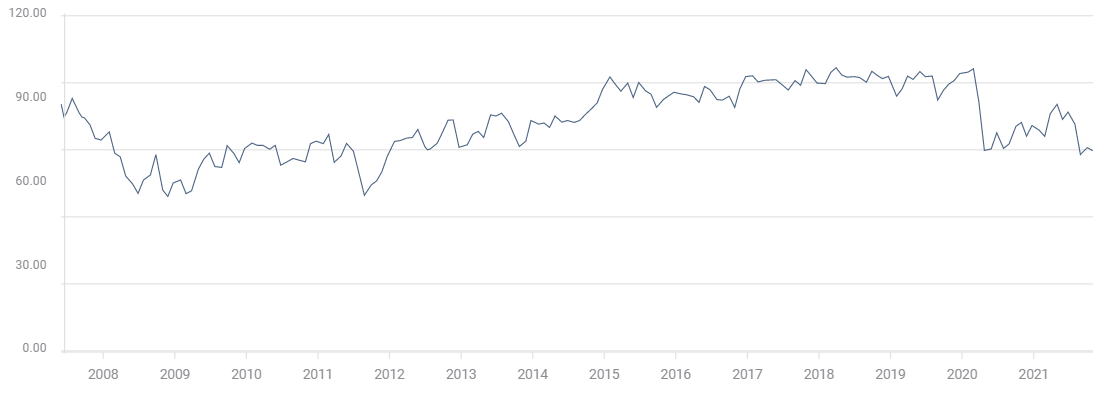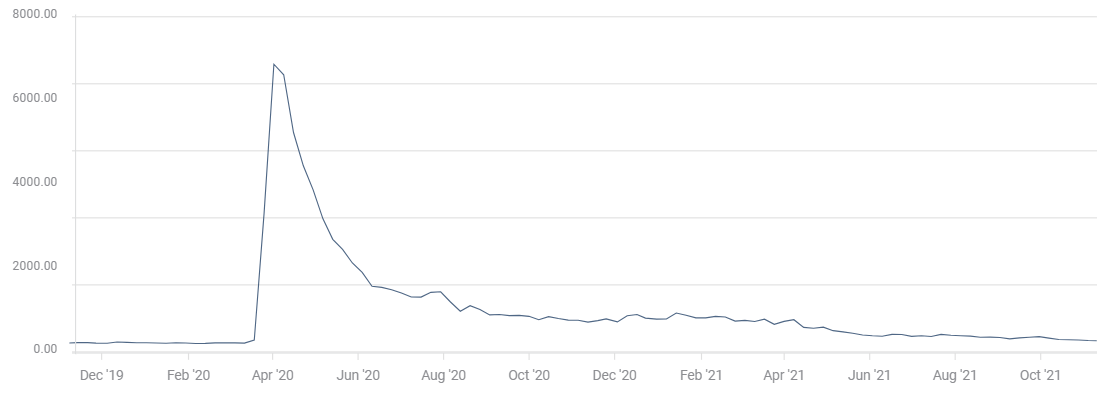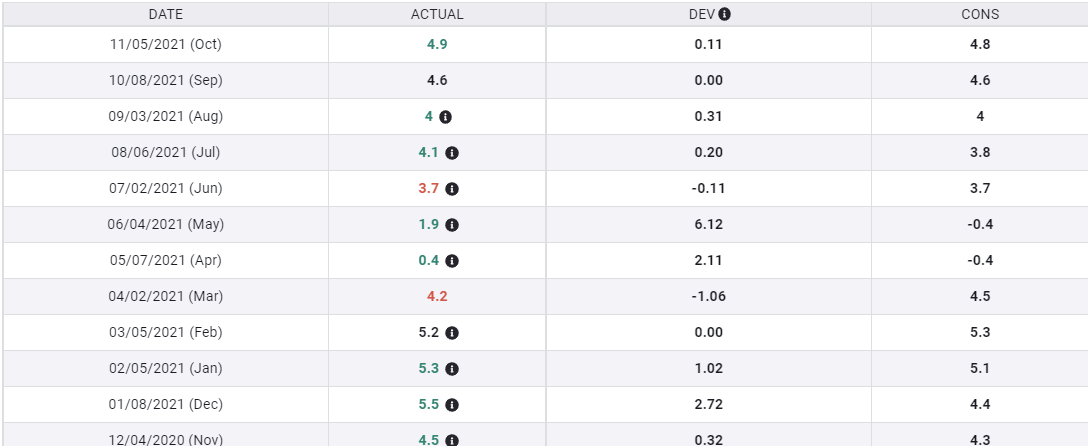- Consumer sentiment forecast to remain near decade low.
- Soaring inflation may be dragging down consumer attitudes despite solid job growth.
- Retail Sales and Personal Spending unaffected, so far, by plunging sentiment.
American economic optimism has been at a decade low for three months and little improvement is expected as mounting inflation steals the wage gains from a tight labor market.
The Michigan Consumer Sentiment Index is forecast to rise slightly to 72.4 in November from 71.7 in October. Since plunging to 70.3 in August, below last April’s pandemic low of 71.8, the Michigan Index has averaged 71.6, its weakest reading in a decade.
Michigan Consumer Sentiment
NFP, JOLTS, and Initial Jobless Claims
Jobs are the normal touchstone for consumer outlook. When workers are confident that employment is readily available and wages are rising, Americans are optimistic.
Nonfarm Payrolls (NFP) rose 531,000 in October and have averaged 403,000 for three months and 646,000 for six. The Job Openings and Labor Turnover Survey (JOLTS) has had an all-time record average of 9.8 million positions on offer each month since February.
JOLTS
FXStreet
The US labor market has had a number of fitful months, particularly in August and September when initial readings of 235,000 and 194,000 seemed to indicate a rapid decline in job creation. October’s performance and upward revision to the two prior months alleviated most of that concern.
Initial Jobless Claims have been under 300,000 for five weeks. At 267,000 in the beginning of November they are approaching the levels of late 2019 before the pandemic lockdowns crushed employment.
Initial Jobless Claims
FXStreet
Several factors, including generous unemployment benefits, pandemic restrictions and Covid fears head the list of reasons why many workers have been slow to return to employment. Job availability is not one. Anyone one in the country who wants to find work can do so.
Inflation and Wages
The labor shortage has forced many employers to raise wages. Annual gains in Average Hourly Earnings have soared from 1.9% in May to 4.9% in October.
Average Hourly Earnings
FXStreet
Unfortunately for American workers, inflation has risen even faster. Wages have not outstripped the Consumer Price Index (CPI) since March. Annual real wages (wages minus inflation) of US workers have declined steadily for seven months: April -3.8%, May -1.9%, June -1.7%, July -1.3%, August -1.3%, September -0.8% and October -1.3%.
CPI
There is little for workers to celebrate in these numbers.
Market potential
Consumer sentiment is usually a data point of secondary importance. What the number tells the market about consumption and the 70% of US economic activity tied to consumer activity is its main interest.
For the November Michigan figures, the risk is for a further deterioration in consumer attitudes. Sooner or later the extremely weak outlook will begin to affect Retail Sales. The longer sentiment is at rock bottom the greater its potential drag on consumption.
The US economy expanded at a 2% annualized rate in the third quarter. Until now consumer spending has been relatively firm. Retail Sales averaged 0.8% in August and September and Personal Spending was 1.0% and 0.6%.
If consumption falters, combined with all of the other labor, supply, inflation and distribution problems, the economy would be hard pressed to maintain positive growth.
Lower or negative US growth would sow doubt for the Federal Reserve’s taper plans, in turn inhibiting US Treasury yields and the dollar.
The Fed may not need an ebullient US consumer for its monetary policy, but it fears a creeping consumer depression.
October’s Retail Sales figures will be reported on November 17.
Information on these pages contains forward-looking statements that involve risks and uncertainties. Markets and instruments profiled on this page are for informational purposes only and should not in any way come across as a recommendation to buy or sell in these assets. You should do your own thorough research before making any investment decisions. FXStreet does not in any way guarantee that this information is free from mistakes, errors, or material misstatements. It also does not guarantee that this information is of a timely nature. Investing in Open Markets involves a great deal of risk, including the loss of all or a portion of your investment, as well as emotional distress. All risks, losses and costs associated with investing, including total loss of principal, are your responsibility. The views and opinions expressed in this article are those of the authors and do not necessarily reflect the official policy or position of FXStreet nor its advertisers. The author will not be held responsible for information that is found at the end of links posted on this page.
If not otherwise explicitly mentioned in the body of the article, at the time of writing, the author has no position in any stock mentioned in this article and no business relationship with any company mentioned. The author has not received compensation for writing this article, other than from FXStreet.
FXStreet and the author do not provide personalized recommendations. The author makes no representations as to the accuracy, completeness, or suitability of this information. FXStreet and the author will not be liable for any errors, omissions or any losses, injuries or damages arising from this information and its display or use. Errors and omissions excepted.
The author and FXStreet are not registered investment advisors and nothing in this article is intended to be investment advice.
Recommended Content
Editors’ Picks

EUR/USD treads water just above 1.0400 post-US data
Another sign of the good health of the US economy came in response to firm flash US Manufacturing and Services PMIs, which in turn reinforced further the already strong performance of the US Dollar, relegating EUR/USD to the 1.0400 neighbourhood on Friday.

GBP/USD remains depressed near 1.2520 on stronger Dollar
Poor results from the UK docket kept the British pound on the back foot on Thursday, hovering around the low-1.2500s in a context of generalized weakness in the risk-linked galaxy vs. another outstanding day in the Greenback.

Gold keeps the bid bias unchanged near $2,700
Persistent safe haven demand continues to prop up the march north in Gold prices so far on Friday, hitting new two-week tops past the key $2,700 mark per troy ounce despite extra strength in the Greenback and mixed US yields.

Geopolitics back on the radar
Rising tensions between Russia and Ukraine caused renewed unease in the markets this week. Putin signed an amendment to Russian nuclear doctrine, which allows Russia to use nuclear weapons for retaliating against strikes carried out with conventional weapons.

Eurozone PMI sounds the alarm about growth once more
The composite PMI dropped from 50 to 48.1, once more stressing growth concerns for the eurozone. Hard data has actually come in better than expected recently – so ahead of the December meeting, the ECB has to figure out whether this is the PMI crying wolf or whether it should take this signal seriously. We think it’s the latter.

Best Forex Brokers with Low Spreads
VERIFIED Low spreads are crucial for reducing trading costs. Explore top Forex brokers offering competitive spreads and high leverage. Compare options for EUR/USD, GBP/USD, USD/JPY, and Gold.




